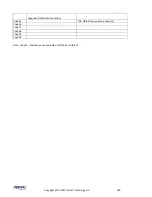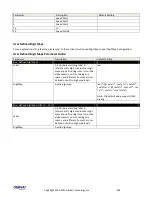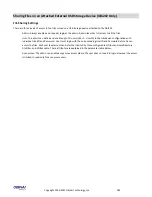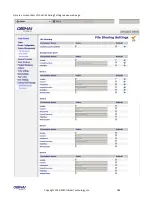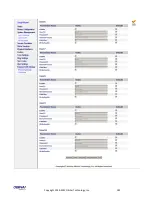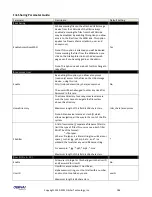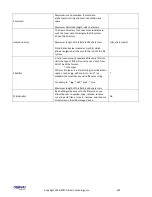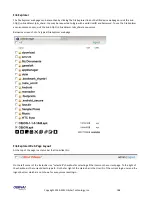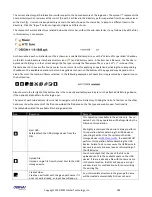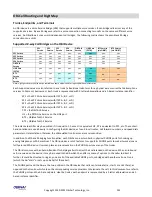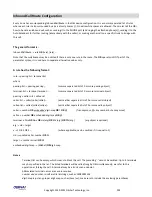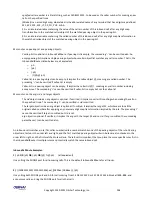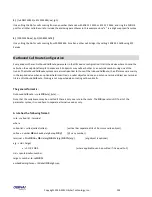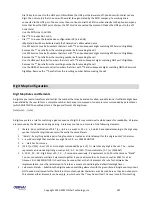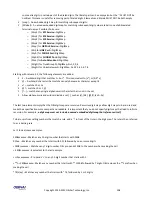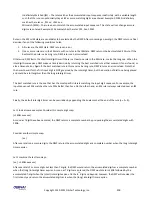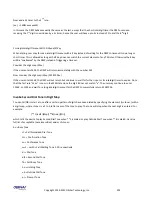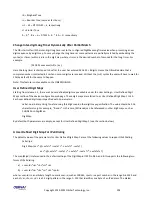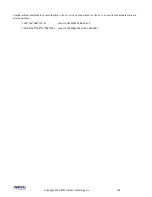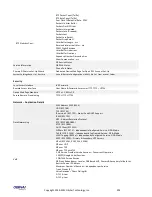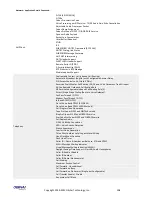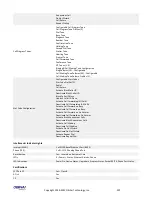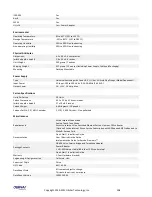
Copyright 2010-2013 Obihai Technology, Inc.
194
-
spoofed-caller-number
is a literal string, such as 14081112233, to be used as the caller number for making a new
call on the specified trunk
-
(M
label
) is a named digit map, where
label
is the abbreviated name of any terminal that has a digit map defined:
SP1, SP2, SP3, SP4, LI
1
, PP, PH, PH2, or AA
-
$1 is an internal variable containing the value of the caller number of this inbound call, after any digit map
transformation in the matched
caller
object of the matched
peering
object in the
peering-list
.
-
$2 is an internal variable containing the called number of this inbound call, after any digit map transformation in
the matched
callee
object of the matched
peering
object in the
peering-list
.
More notes on
peering-list
and
peering
objects:
-
Peering-list
is optional in InboundCallRoute. If
peering-list
is empty, the succeeding ‘:’ can be omitted also. An
empty
peering-list
implies a single
peering
object whose
caller
object list matches any caller number. That is, the
InboundCallRoutes listed below are all equivalent
o
ph
o
{ph}
o
{:ph}
o
{?|@>@:ph}
-
Callee-list
in a
peering
object can be empty. It implies the
callee
object @, meaning any called number. The
preceding ‘>’ can be omitted if callee-list is empty.
-
Caller-list
in a
peering
object can be empty. It implies the
caller-list
@|?, meaning any caller number including
anonymous. The succeeding ‘>’ cannot be omitted if caller-list is empty but not the callee-list
More notes on the
arg
,
cid
,
and
target
objects:
-
The
cid
object inside an
arg
object is optional. If omitted, it implies no caller-ID spoofing when making the call on
the specified trunk. The succeeding ‘>’ can be omitted is
cid
is omitted
-
The
target
object inside an
arg
object is optional. If omitted, it implies the
target
$2, which means to call the
original called number after applying any necessary digit map transformation implied by the rule. The preceding ‘>’
cannot be omitted if
target
is omitted but cid is not
-
arg
object is optional. If omitted, it implies the
arg
with the
target
$2 and no
cid
. If
arg
is omitted, the succeeding
parentheses ( ) can be omitted also.
An inbound call matches a rule if its caller-number/callee-number matches one of the
peering
objects of the rule.
Peering
objects are tested in the order left and right, and the first matched
peering
object will win. Rules are also checked in the
order left to right, and the first matched rule will win. Therefore it is important that you place the more specific rules first in
the InboundCallRoute if multiple rules can potentially match the same inbound call.
InboundCallRoute Examples:
1)
ph
OR
{ph}
OR
{:ph}
OR
{@|?>@:ph} (all equivalent)
It says: Ring the PHONE port for all incoming calls. This is the default InboundCallRoute for all trunks.
2)
{(14081223330|15103313456):aa},{(1800xx.|1888xx.):},{ph}
It says: Ring both PHONE port and AA for calls coming from 1 408 122 3330 or 1 510 331 3456, block all 800, 888, and
anonymous calls, and ring the PHONE port for all other calls
Summary of Contents for OBi100
Page 54: ...Copyright 2010 2013 Obihai Technology Inc 54...
Page 55: ...Copyright 2010 2013 Obihai Technology Inc 55...
Page 58: ...Copyright 2010 2013 Obihai Technology Inc 58...
Page 75: ...Copyright 2010 2013 Obihai Technology Inc 75...
Page 100: ...Copyright 2010 2013 Obihai Technology Inc 100...
Page 109: ...Copyright 2010 2013 Obihai Technology Inc 109 SP1 SP2 SP3 and SP4 Services...
Page 126: ...Copyright 2010 2013 Obihai Technology Inc 126...
Page 135: ...Copyright 2010 2013 Obihai Technology Inc 135...
Page 140: ...Copyright 2010 2013 Obihai Technology Inc 140...
Page 157: ...Copyright 2010 2013 Obihai Technology Inc 157...
Page 158: ...Copyright 2010 2013 Obihai Technology Inc 158...
Page 159: ...Copyright 2010 2013 Obihai Technology Inc 159...
Page 174: ...Copyright 2010 2013 Obihai Technology Inc 174...
Page 185: ...Copyright 2010 2013 Obihai Technology Inc 185...

